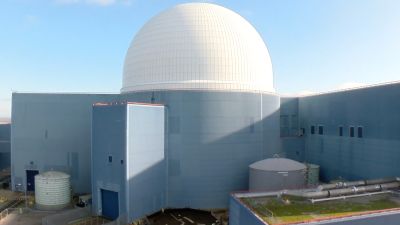How UK nuclear power station Sizewell B works as COP26 raises questions about the future of energy

How does a nuclear power station work? ITV News Anglia's Tanya Mercer finds out.
Energy was at the centre of the COP26 climate summit debate as world leaders negotiated how we can power our lives - without destroying the planet.
While some say nuclear is the future of clean renewable energy, it remains hugely divisive.
Critics say it is too expensive, creates radioactive waste, poses a security risk and is too destructive to the surrounding areas.
But its supporters argue its reliability and efficiency make it a cleaner fuel worth investing in.
Beneath the big white dome familiar to Suffolk coastline visitors is a complex operation, which has been generating around 3% of the UK's power for 26 years.
And plans are in for a new plant, Sizewell C, which could result in two more nuclear reactors being built, if planning and government permissions are granted.
As the debate rages over how and whether to expand the UK's nuclear power capacity, ITV News Anglia reporter Tanya Mercer went inside Sizewell B for a tour.
Why are we talking about nuclear power?
Currently the UK has seven nuclear power stations.
Nuclear strategy is a key focus of Boris Johnson's future energy investment, as the government backs Sizewell C plans and Rolls Royce's development of small reactors to power single cities.
The government has also vowed to boost the UK's offshore wind power, and offer grants for households to swap out old gas boilers for heatpumps in its net zero strategy.
The UK could boost its nuclear energy capacity as an alternative to coal power.
The Prime Minister was criticised last week after he hailed a watered-down version of the Glasgow Pact to 'phase down' rather than 'phase out' the fossil fuel, after China and India led pushback on the issue.
Coal production in the UK has already been declining since the industrial age.
Advocates of the energy source view nuclear as a key part of the UK's "green revolution" to future-proof energy supplies.
The Sizewell C proposal is promising more UK jobs - but is also facing local opposition from campaigners with environmental concerns.
Campaigners tell ITV Anglia they want the government to halt funding for Sizewell C:
How does a nuclear power station work?
Sizewell B Station Director Robert Gunn explains how the reactor - the station's main power house - produces heat by nuclear fission - to power 2 million homes.
The reactor is fuelled by uranium pellets. Each pellet contains the same amount of energy as 800kg of coal, and the reactor contains more than 18 million pellets.
When these pellets are introduced to a radioactive source, the fission process begins, splitting millions of atoms apart.
It creates a huge amount of heat which then powers the station.
How much water does it use?
Sizewell B is the UK's only pressurised water reactor. It works by heating water taken from the North Sea to create steam.
The water needs to reach a very high temperature - approximately 325C - to create the right amount of steam at the right pressure to turn the turbines.
Sizewell B houses two enormous turbines - each using 1 tonne of steam per second to generate 630 megawatts of electricity.
The whole process uses a huge amount of water: to generate the steam, to drive the turbines and then to cool the steam down to go round again.
Mr Gunn explains how it uses 3 million litres a minute, before the steam converts back into water which goes back into one circuit.
The water then goes back out into the sea a few degrees warmer.
What happens to the nuclear waste?
Radioactive used fuel is the byproduct of the whole process, which must be handled with care.
Mr Dunn explained that spent fuel goes into a fuel storage point for a number of years before it is transferred to casks.
It is kept on site in dry fuel store for 100 years, then moved to an underground repository.
Are more nuclear power plants in the UK needed? Watch ITV Anglia's previous reporting on the Sizewell C proposal
Nuclear sites are licensed for a set number of years.
But Mr Dunn hopes Sizewell B will be allowed to extend the life of site by at least 20 years.
The station, which opened in 1995, is due to run until 2035.
But the goal is to keep it running until 2055, Mr Dunn said.
"That will involve hundreds of millions of pounds of investment and we're already getting ourselves organised to put that in - which will many jobs for many companies."